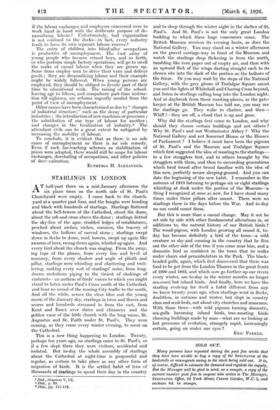STARLINGS IN LONDON
AT half-past three on a mid-January afternoon the six plane trees on the north side of St. Paul's Churchyard were empty. I came back to the, church- yard at a quarter past four, and the boughs were bending And black with hundreds of starlings. Starlings fluttered about the bell-towers of the Cathedral,- about the dome, about the orb and cross above the dome ; starlings dotted the sky-line of the apse, studded ledges of entablatures, perched about arches, niches, cornices, the tracery of windows, the hollows of carved stone ; starlings swept down in flocks to dome, roof, towers, swept up again like swarms of bees, swung down again, whirled up again. And every bird about the church was singing. From the sway- hig tops of the planes, from every line and level of masonry, from every shadow and angle of plinth and pillar, starlings were whistling and chattering and twit- tering, making every sort of starlings' noise, from long- drawn melodious piping to the tiniest of shakings of castanets—an anthem of birds' voices to which you might stand to listen under Paul's Cross north of the Cathedral, and hear no sound of the roaring City traffic to the south. And all the while, across the clear blue and the young moon of the January sky, starlings in twos and threes and scores and hundreds streamed in from the east, from Kent. and Essex over slates and chimneys and the golden vane of ,the little church with the long name, St. Augustus and St. Faith under St. Paul's. They were coming, as they come every winter evening, to roost on the Cathedral.
This is a new thing happening to London. Twenty, perhaps- ten years ago, no starlings came to St. Paul's, or if a few slept there they were visitors, accidental and isolated. But to-day the whole assembly of starlings about the Cathedral at night-time is purposeful and regular, as certain to take place as any other form of migration of birds. It is the settled habit of tens of thousands of starlings to spend their day in the country Ibid., chapters V, IX. 2 /bid., p. 99. * Ibid., pp. III-113. and to sleep through the winter night in the shelter of St. Paul's. And St. Paul's is not the only great London building to which these huge concourses come. The British Museum receives its evening hosts, so does the National Gallery. You may stand on a winter afternoon on the gravel carriage-way in front of the Museum and watch' the starlings drop flickering in from the north, tumbling like torn paper out of empty air, and then with an upWard flick of the wings darting straight each to its chosen site into the dark of the portico or the hollows of the frieze. Or you may wait by the steps of the National Gallery, with the grey gloom of Trafalgar Square about you and the lights of Whitehall and Charing Cross beyond, and listen to starlings calling long into the London night.
And at daybreak from' those roosting-places, as the gate- keeper at the British Museum has told me, yOu may see the starlings go. They wake to chatter, and then— Whiff !—they are off, a cloud that is up and gone.
Why did the starlings first come to London, and why _ _ should they choose certain buildings and not others ? Why St. Paul's and not Westminster Abbey ? Why the National Gallery- and not Somerset House or the Houses of Parliament ? I believe it must have been the pigeons of St. Paul's and the Museum and Trafalgar Square which first suggested the idea of roosting to the starlings— to a few stragglers first, and to others brought by the stragglers with them, and then to succeeding generations which bred brood after brood familiar with the idea of this new, perfectly secure sleeping-ground. And you can date the beginning of the new habit. I remember in the autumn of 1919 listening to perhaps six or eight starlings whistling at dusk under the portico of the "Musetima thing I recognized at once as new, for I have stood many times under those pillars after sunset. There were no starlings there in the days before the War. And to-day no one could count them.
But this" is more than a casual change. May it not be set side by side with other fundamental alterations in, or additions to, the natural history of our British birds ? The wood-pigeon, with London growing all round it, to- day has become definitely a bird of the town—a wild creature so shy and cunning in the country that he flies out the other side of the tree if you come near him, and a domestic bird so confident in the town that he walks under chairs and perambulators in the Park. The black- headed gulls, again, which first discovered that there was food to be got from the London Thames in the great frosts of 1890 and 1895, and which now go further up our rivers every winter, are to-day in the winter months no longer sea-coast but inland birds. And finally, here we have the starling evolving for itself a habit different from any we knew twenty years ago, when starlings went in flocks, doubtless, in autumn and winter, but slept in country elms and reed-beds, not about city churches and museums. With these three—with wild pigeons turning domestic, sea-gulls becoming inland birds, tree-roosting birds choosing buildings made by man—what are we looking at but processes of evolution, strangely rapid, increasingly certain, going on under our eyes ?
ERIC PARKER.






































































 Previous page
Previous page